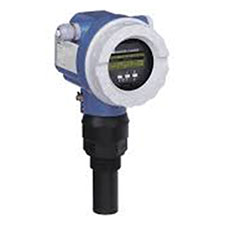
The working principle of ultrasonic tank surface sensor
The ultrasonic sensor mounts on the surface of the tank above the tank and transmits an ultrasonic pulse into the tank. This pulse travels at the speed of sound, returning from the surface of the liquid to the transmitter. The ultrasonic transmitter measures the latency between the transmitted and received echo signal and the in-range microprocessor calculates the distance from the liquid surface using the formula. Distance = (sound speed in time x air delay) / 2 When the ultrasonic transmitter is programmed with a low reference program – usually below the tank – the liquid level is calculated by the microprocessor. The basic equation is to calculate the tank level. Level = tank height – distance

Basic concept and elements of ultrasonic sensor surface measurement of tanks
Minimum distance measurement (Xm): (Also known as “dead band”) is a common feature for all ultrasonic level meters. This is a short range in front of the sensor where the ultrasonic device cannot measure
Maximum measuring distance (XM): The longest distance in ideal conditions where the device can measure. No measurement beyond this distance is possible with an ultrasonic level transmitter, which performs calculations to convert the wavelength travel to the level measure in the tank. The time elapsed between burst sound and direct return echo is proportional to the distance between the transducer and the material on board. This material usually has air from the surface of the material but can be a blanket of some other gases or vapors. This tool measures the time to burst to the level of reflection and return. This time will be proportional to the distance from the converter to the surface and can be used to determine the level of liquid in the tank. This basic principle lies at the heart of ultrasonic measurement technology and is shown in Equation: Distance = (Sound x Time) / 2. These non-contact devices are available in models that can convert readings to 4-20 mA output to DCS, PLC or other remote systems. The frequency range for ultrasonic methods is in the range of 15… 200 kHz. Low frequency tools are used for more difficult applications. Such as longer distances and solid surface measurements and higher frequency measurements are used to measure shorter liquid levels
For practical applications of the ultrasonic measurement method, a number of factors must be considered. Some important points are
The speed of sound through the environment (usually air) varies with the average temperature. The converter may have a temperature sensor to change the operating temperature changes, which increases the speed of sound, and hence calculates the distance that determines the exact level measurement. Temperature compensation is provided to respond to the uniform temperature variance of the ambient sound. The temperature sensor is placed inside the transducer and the signal is sent to the transmitter via the transducer wiring. Optionally, an alternating temperature sensor can be used to provide the temperature input instead of the integral temperature sensor. If the ambient ambient temperature remains constant, the desired temperature may be entered during the transmitter configuration instead of using the integral temperature compensation or remote sensor
The presence of heavy foam / dust on the surface of the material can act as a sound absorber. In some cases, absorption may be sufficient to prevent the use of ultrasonic techniques. To increase efficiency where foam / dust or other factors affect the motion of the wave from the liquid surface and from the liquid surface, some models may have a beam guide attached to the transducer
Advantages of Ultrasonic Transmitters
Ultrasonic transmitters are easily installed on empty tanks or tanks containing liquid
Setup is easy, and on-board programming devices can be set up in minutes
Because there is no contact with the media and moving parts, the devices are almost maintenance-free. Wet materials are usually an inert fluoropolymer and are resistant to corrosion of condensing vapors
Because the device is non-contact, surface measurement is unaffected by changes in liquid density, dielectric or viscosity, and works well in aqueous liquids and many chemicals
A change in process temperature increases the speed of the ultrasonic pulse in the upper liquid space, but the internal temperature compensation automatically corrects this problem
Process pressure changes do not affect the measurement
Limitations
Ultrasonic transmitters rely on pulses that are ineffective during flight. Liquids that produce heavy vapors, vapors, or vapor barriers should be avoided (use a radar transmitter in these cases). Vacuum applications are not possible because the pulse requires air to pass through the air
Construction materials generally limit the process temperature to about 158 ° F (70 ° C) and the pressure to 43 psig (3 bar)
The condition of the fluid level is also important. Some disturbances are tolerable, but foaming often causes the return sound to disappear
Obstructions in the tank, such as pipes, reinforcing bars, and agitators, will cause false stools, but most transmitters have sophisticated software algorithms that can mask or ignore these fans
Ultrasonic transmitters can be used in silos containing dry products such as pellets, grains or powders, but they are difficult to prepare. Factors such as solution surface angle, dust and distance must be considered. A Guided Wave Radar transmitter is more suitable for dry product applications
Rose Calibration Company in Melbourne, Australia with over ten years of experience provides all calibration, maintenance, and repair services throughout Australia. If you live in Sydney, Melbourne, Adelaide, Perth, Geelong, and Brisbane, you can receive your quote in less than two hours by fill-up the form via the “Booking” link.

